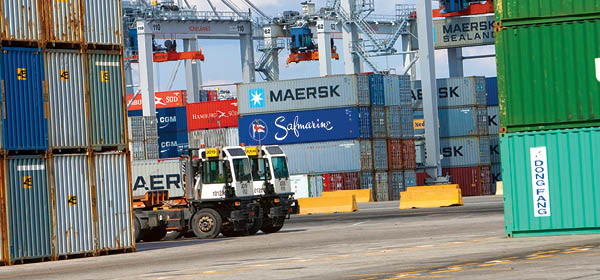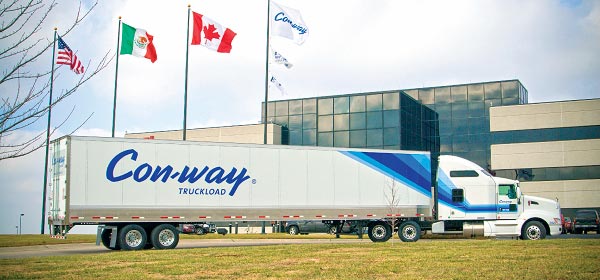
Maximizing Global Logistics Management Effectiveness
Q: What are the biggest challenges shippers face with globalization in today’s market? A: Many shippers face the challenge of orchestrating an end-to-end process and managing interplay with third parties, such as customers, suppliers, ocean carriers, freight forwarders, customs brokers, and government agencies. Doing so effectively is difficult, regardless of whether the shipper is importing […]
Read More
Trends—April 2012
Southern Accent: Supply, Demand Shifts Underline Southeastern Market A slow and steady stream of manufacturers and retailers has been feeling out the U.S. Southeast over the past decade. The trickle began in 2002 following the West Coast port strike, when many shippers swallowed losses and began exploring all-water alternatives from Asia to the U.S. hinterland. […]
Read More
Global Logistics—April 2012
UPS Buys TNT Express, Shifting Global Balance UPS’ estimated $6.77-billion acquisition of Netherlands-based TNT Express puts to rest lingering speculation about the future of Europe’s number-two express mail provider following competition from FedEx and U.S. economic uncertainties. The move clearly places UPS in a new position of strength among its U.S. competitors and German expediter […]
Read More
Cross-Border Shipping: The Road Now Taken
Electronics manufacturer Siemens switches from air freight to over-the-road transport for shipments from Mexico to the United States and Canada and lights up savings.
Read More
Logistics in Alaska: Taming the Last Frontier
Shipping to and from the wilds of Alaska requires the expertise and specialized equipment offered by intrepid transportation providers.
Read More
Packaging Grows Green
Many shippers are looking to replace fossil fuel-based packaging materials with more sustainable options. But they must do their homework to find the best—and greenest—fit.
Read More
Technology Enables You to Be Positively Different
Q: How can logistics technologies be utilized as a competitive differentiator? A: Most companies prefer to attract customers by providing unique brand-driven customer experiences and services rather than competing on price. Strategic and practical use of the right technologies enables sharp pricing competitiveness, creates better customer experiences, reduces expenses, and raises productivity. The evolution of […]
Read More
Collaborative Trade Communities Keep Companies Competitive
Q: What is the primary advantage of Collaborative Trade Communities? A: The way they function is much simpler than how most companies do business today. We spend a significant amount of effort and time tracking what our supply chain partners are doing. This includes sending instructions and entering them into corresponding systems, communicating and updating […]
Read More
Automated Routing: The Path to Optimization
Q: What guidance can you offer firms exploring routing and scheduling technologies for the first time? A: Automation is a great benefit of logistics technology—though not the only one. Technologies that automate time-consuming, repetitive jobs free us up to do what humans excel at: spotting and dealing with change and exceptions. It can take numerous […]
Read More
The Right ERP Solution Puts All the Pieces Together
Q: How can today’s manufacturers deal with increasing regulations, demand volatility, and shifting global trade currents? A: Success for manufacturers today depends on agility. The one certainty with global trade currents, regulations, and demand is that they will change, and your ability to adapt defines your growth potential. A well-implemented enterprise resource planning (ERP) solution […]
Read More
Leveraging Lean and Labor Management
Q: In the context of retail, what is lean labor management and what does it entail? A: Lean has origins in manufacturing, but some of its concepts apply in the retail space—notably, reducing waste and increasing quality. Using these lean components as a foundation for labor management increases productivity and reduces costs in a warehouse […]
Read More
KPI Data Creates Improvement Opportunities
Q: What are the latest logistics software innovations? A: Improving how key performance indicators (KPIs) specific to freight are developed, measured, and managed seems to be a growing theme with leading software providers. KPIs are used to collect and measure actionable data to help improve accurate shipping decision-making and processes. The key word is actionable. […]
Read More
Bringing Clarity to Visibility Solution Investments
Q: How do you define visibility? A: Visibility is understanding the location and current status of key assets—whether on-time shipments or inventory stockouts. Visibility boils down to three elements: orders, shipments against orders, and inventory. Q: Why is supply chain visibility such a challenge for companies? A: Visibility is hard to quantify. Companies may make […]
Read More
IT: Advantage @Light Speed
A professor at a well-known university recently remarked at a logistics conference, "Information technology is not a source of competitive advantage. It makes good systems better, and bad systems worse. It allows companies to do stupid things at the speed of light." Maybe. But IT can be a change agent that will almost always open […]
Read More
Taking Control of Transportation Spend Management
Q: Cloud computing is fast becoming a reality of everyday business life. How can companies get started in leveraging interconnected shared logistics platforms, and why does it save time and money? A: As enterprises strive to show almost-immediate return on investment, they seek solutions that are globally accessible, scalable, and require minimal up-front investment. Maintaining […]
Read More
World-Class Logistics Operations Require Multi-Party Processes and Technology
Q: How can supply chain technology help businesses improve logistics operations? A: The majority of IT solutions available today constrain logistics operations performance. Most logistics problems are inter-enterprise, but the majority of logistics technology solutions are enterprise-focused. As a result, too much of the coordination still takes place over email and phone, and only involves […]
Read More
GTM Solutions Keep Businesses Plugged In
Q: Why is it difficult for organizations to integrate true end-to-end global trade management? A: True end-to-end global trade management (GTM) means managing and optimizing all the functions required to move goods across international borders. Organizations may argue that they are already doing GTM, when in fact they are only undertaking disparate pieces, such as international […]
Read More
Second-Generation Logistics Software: Accessible Anywhere
Q: What is the latest logistics software trend? A: Transportation management systems (TMS) have morphed into communication hubs with Web and mobile access. The PC user interface for employees—while still crucial—is becoming much less important than it once was. Q: How can that be? The first generation of software focused on employees adding and viewing […]
Read More
The 2012 Top 100 Logistics IT Providers & Market Research Survey
Inbound Logistics’ annual logistics technology market research report delivers exclusive insights on logistics technology trends, and reveals this year’s best-in-class vendors.
Read More
All-in-One
An ERP solution equipped with supply chain management functions gives businesses all the logistics tools they need.
Read More